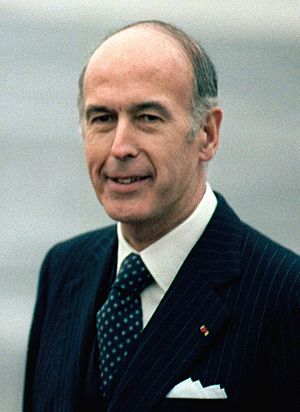Convention on the Future of Europe facts for kids
The Convention on the Future of the European Union, often called the European Convention, was an important group created in December 2001. It was set up by the European Council, which is a meeting of leaders from countries in the European Union. This happened after a special meeting called the Laeken Declaration.
The main idea for this Convention came from the Philadelphia Convention in the United States. That meeting helped create the basic rules, or Constitution, for the United States. The European Convention had a similar goal: to write a set of main rules for the European Union. These rules would be like a "constitution" for the EU.
The Convention worked hard and finished its job in July 2003. They created a plan called the Draft Treaty establishing a Constitution for Europe. This draft was then given to the European Council to review and approve.
Contents
What Was the European Convention?
The European Convention was a special meeting of people from different parts of Europe. Their job was to think about the future of the European Union. They wanted to make the EU work better and be more understandable for everyone.
Why Was It Created?
The European Union was growing, with more countries joining. Leaders felt it was time to update how the EU worked. They wanted to make its rules clearer and more democratic. The Laeken Declaration in 2001 asked for this Convention to help plan these changes.
Who Was Involved?
The Convention had many members. These included:
- Representatives from the governments of each EU country.
- Members of the European Parliament, which is like the EU's elected assembly.
- Members of national parliaments from each country.
- Representatives from the European Commission, which is the EU's executive body.
The Convention was led by Valéry Giscard d'Estaing, a former President of France.
What Did the Convention Do?
The Convention held many meetings and discussions over about 18 months. They talked about important topics like:
- How to make the EU more democratic.
- How to make decisions faster and more clearly.
- What powers the EU should have.
- How to simplify the many treaties and rules of the EU.
The Draft Treaty
After all their discussions, the Convention wrote a detailed plan. This plan was called the "Draft Treaty establishing a Constitution for Europe." It was a long document that suggested many changes to how the EU operated. It aimed to bring all the EU's main rules into one clear text.
The draft included ideas for:
- A new president for the European Council.
- A foreign minister for the EU.
- Making it easier for citizens to have a say.
- Simplifying the EU's laws and decision-making.
What Happened Next?
The Draft Treaty was a big step, but it wasn't the final law. After the Convention finished its work in 2003, the leaders of the EU countries took over. They discussed the draft and made some changes.
Eventually, this led to the signing of the Treaty establishing a Constitution for Europe in 2004. However, not all countries agreed to it, and it never fully came into force. Many of its ideas were later included in the Treaty of Lisbon, which became law in 2009.
See also
 In Spanish: Convención sobre el futuro de Europa para niños
In Spanish: Convención sobre el futuro de Europa para niños


